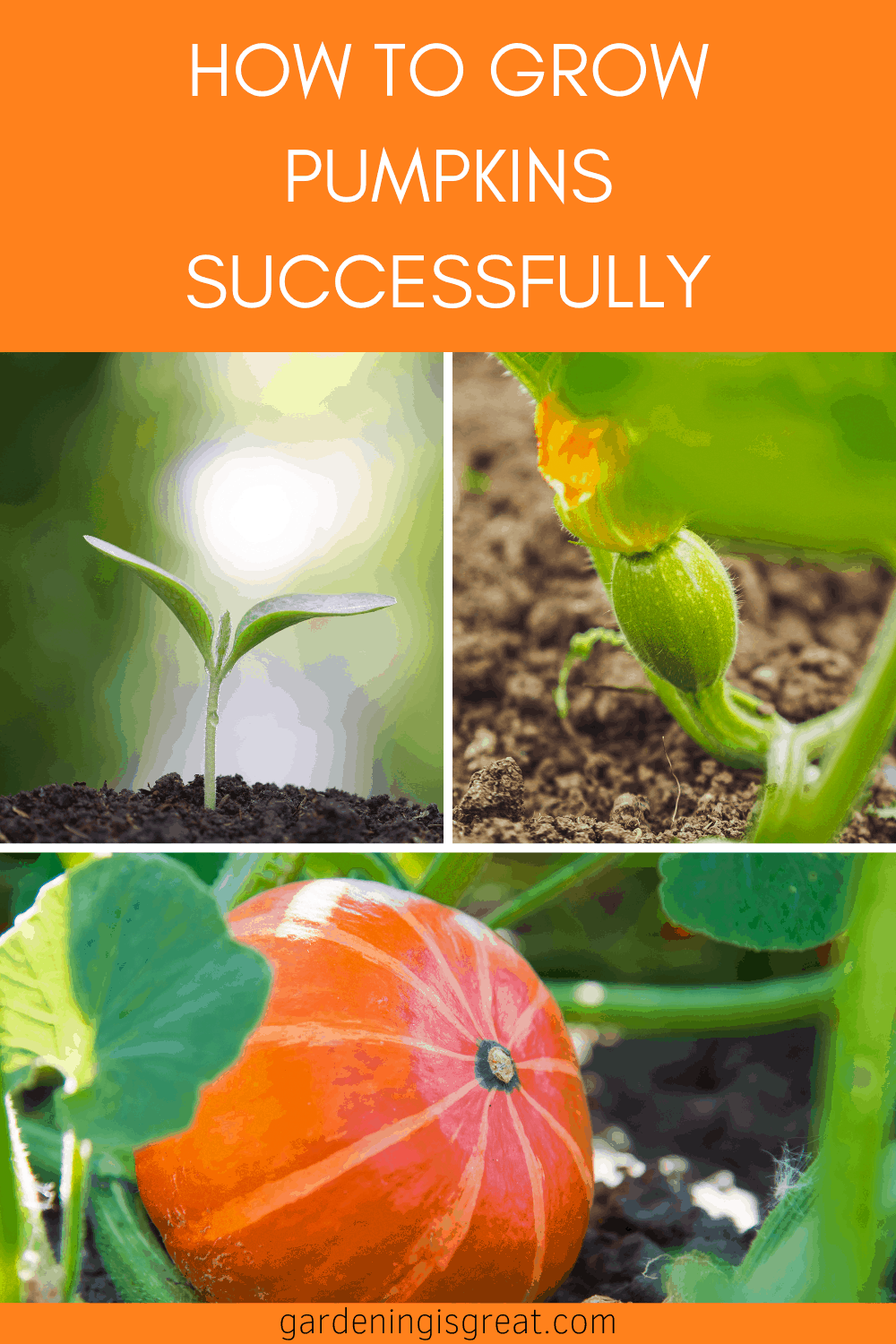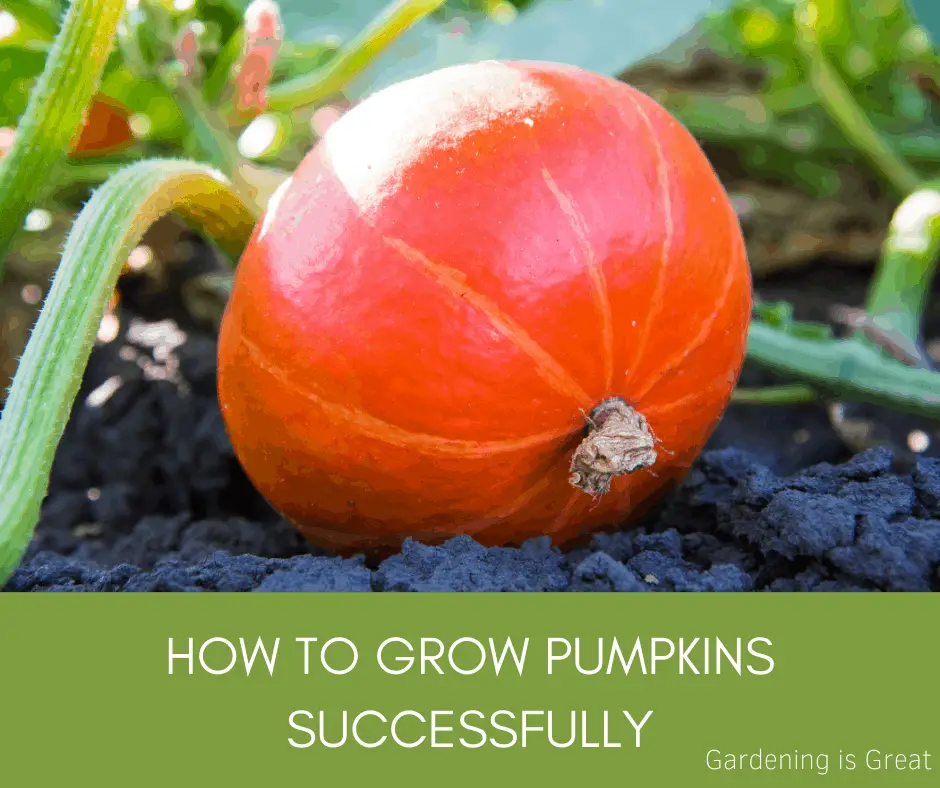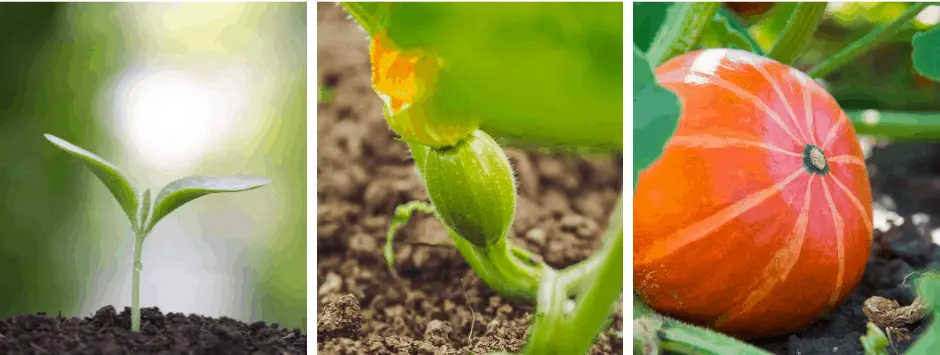How To Grow Pumpkins Successfully
Pumpkins are a signature symbol of Fall. They grow throughout the summer, ready to be eaten in warm soups and stews as the weather turns colder. Or used to make jack-o-lanterns for Halloween.
But what if you want to grow your own pumpkins ready for Fall? When should you plant them and how do you grow pumpkins successfully?
This guide will help you to grow pumpkins in your garden, whether you are choosing to grow them in containers or directly in the soil. We will cover what pumpkins need and step-by-step directions on how to grow pumpkins.

What Do Pumpkins Need To Grow Successfully
As with many vegetables and fruits, there are specific conditions that help pumpkins to grow successfully. Pumpkins can grow very large in size but in order to do so, they need space, plenty of water, sunlight, and nutrients.
Space
As mentioned, pumpkins can grow to a large size. Their vines also are sprawling which means they spread out everywhere unless they are nipped.
In order to grow pumpkins, it is important to dedicate a lot of space in your garden for them. If you have a smaller garden, or perhaps a paved garden, do not despair. You can still grow your own pumpkins, but perhaps in a large container or grow bag instead.
If planted too close together, your pumpkins will compete for resources and won’t reach their optimum growth.
Ideally, plant your pumpkins at least 2 feet apart from each other to provide enough space for growth. If you are growing a large variety of pumpkins, ensure to check how large they can grow and allow for that space accordingly.
If you are choosing to plant within a grow bag, stick to only 1-2 plants per bag. For a container, ensure the container is wide. Pumpkins do not grow deep roots, so a deep container isn’t necessary. However they do grow long vines and of course, the pumpkins themselves are heavy, so will need support from the container.
Water
Pumpkins are large plants and they need a lot of water, especially when the flowers begin to grow. However, it is important to only water the soil around the plant rather than the plant itself.
If pumpkin plants become wet, it can encourage mold and fungus to grow which harms the plant.
It is best to water your pumpkin plants either first thing in the morning or last thing at night when the sun is not too hot. This will ensure the water does not evaporate before reaching your pumpkin plant’s roots.
If you notice the foliage wilting, it is a sign that your pumpkin plant needs more water.
Related: How Often Should You Water Pumpkins?
Sunlight
As with any plant, pumpkins need sunlight to grow. Unlike numerous fruits and vegetables, pumpkins thrive in full sunlight.
The warmth and light are important for pumpkins to be able to grow and flower. If placed in the shade, the plant is unable to develop fully.
Leaves convert sunlight into food for the plant. This food is transported via the vines to help grow larger pumpkins. Without the sunlight, it has a knock-on effect on how much food the leaves produce, and hence you will grow smaller or fewer pumpkins.
Soil
Like all plants, pumpkins get their nutrients from the soil. But not all soil is in optimal condition and might need a little bit of help to prepare for your pumpkin plants.
Firstly, pumpkins love water but do not love to be sat in water. So it is important to dig and turn your soil to improve drainage.
If you live in an area that has particularly clay-heavy soil, I would even recommend adding some sand. The small sand particles help to break up soil and improve water drainage so your roots are not sat in water-drenched soil. If your pumpkin roots become too wet, it will lead to root rot.
Secondly, mix a bag of nutrient-rich compost into your soil. This will help to give your pumpkin plants a good, strong start.
You can then continue to add nutrients to the soil around your pumpkin plants as they grow. This can be through a shop-bought fertilizer. Alternatively, make your own natural fertilizer at home using coffee grounds, banana peel, or compost.
How To Grow Pumpkins
Now that you are more confident in knowing what pumpkins need to grow successfully, we can focus on planting and growing your pumpkins.

Planting
Like most fruits and vegetables, the seeds do best when started indoors. Pumpkins take a long time to grow, so the seeds need sowing ideally around March/April.
The weather can still be unpredictable. Sometimes it’s extremely wet, other times there is a late frost. These are not ideal conditions for growing pumpkins, but start any later in the season and your pumpkins won’t be ready to harvest before winter comes back around.
Find a sunny and warm part of your house where you can place a seed tray. Use compost to fill each section and place one seed around 1cm deep. Cover with compost and spray with water.
If it isn’t possible to grow your pumpkin seeds indoors, do not worry. You can still grow pumpkins directly in the soil from seed, but extra protection will be needed.
Make sure you have prepared your soil by turning and adding compost. Create a hole 3cm deep, place 2-3 seeds inside, and cover with soil. Water the soil gently with a watering can and then cover your seeds with plastic sheeting.
The plastic sheeting will help to keep your seeds warm and protect them from the elements. This is particularly important if you choose to sow your seeds outside.
Remove the plastic sheeting in two weeks after the seedlings have germinated. They will be a little stronger at this point having established routes and it will be late April/early May when the weather is warming up.
If you chose to start your seeds off indoors, now is the time to gradually climatize them to the outdoors. Bring them outside for longer each day until you have reached a full day.
In June, your seedlings will be ready to plant outdoors. This can be done as above directly into the ground. Or you can choose to plant two seedlings spaced 2ft apart in a grow bag, or one seedling in a wide pot.
Growing
Now your seedlings are outdoors, they need plenty of water. Ensure to water the soil around each plant at the coolest part of the day e.g. early in the morning or late at night.
Also, remember to continue to fertilize your pumpkin plants. They require a lot of nutrients that they may not be able to gain 100% from your soil. You can create a natural liquid fertilizer or purchase one. Add this fertilizer directly to the soil around your pumpkin plants every 2 weeks.
As your vines grow, they become heavy and can squish any potential pumpkins. Attend to them each day to gently train them to grow in a certain direction that creates more space for your pumpkins.
Pumpkins grow from the flowers. To encourage more energy towards flower growth, pinch the longer vines once they reach around 2 feet.
As your pumpkin plant flowers, it attracts pollinators. Pollinators are vital to fertilizing your flowers so that they produce pumpkins. If you can, try to encourage pollinators to attend your garden with their favorite plants.
Once your flowers have been fertilized, you may find some fall from the vines. Do not worry! These are the male flowers that attract pollinators. Once they have completed their role they are no longer needed.
The remaining flowers are the fertilized female flowers. These are the important ones as they will produce pumpkins.
At this point, you need to decide if you want lots of smaller pumpkins or a few larger pumpkins.
If you chose the latter, remember to remove any flowers after the first 3-5 pumpkins have started to grow.
This way, the energy from your pumpkin plants will be directed to these few pumpkins, rather than shared amongst a lot of pumpkins. Your pumpkins will be larger than if there were more on each plant.
As your pumpkins grow and touch the ground, cut and place a piece of cardboard underneath it. This will help to raise them off the soil and prevent any potential rot from forming.
Harvesting Your Pumpkins
Pumpkins plants will grow until around September/October, at which point they will be ready for harvesting. You will know when your pumpkins are ready to be harvested as they will be hard and colored all over.
Harvest your pumpkins before the first heavy frost to avoid damage. Use pruning shears and cut it several inches from where it is attached to the stem.

Follow these steps and top tips to achieve growing your pumpkins successfully. Pumpkins require patience, a lot of time, and regular maintenance to encourage growth and protect them from rot, mold, or mildew.
Looking for more guides to grow your fruits and vegetables? Take a look at some of our most popular posts:
